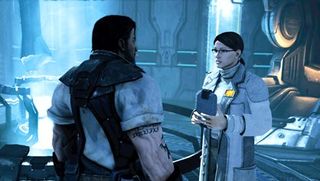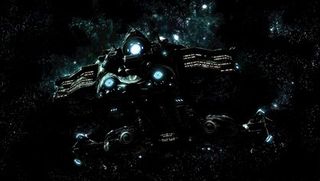To some extent, Blizzard was successful in offering two very powerful options, although it rarely feels as though the choice is an impossible decision. Due to StarCraft II’s open-ended missions and upgrading mechanics, your chosen playing style and selections in the armory can also be major factors in deciding which research path you should take. For example, if you’ve unlocked and powered up a lot of single-target weapons, like the Yamato Cannon and the Banshee Strike, large single units, like Ultralisks, aren’t a cause for concern, but swarms of Zerglings can easily overwhelm your forces. In this case, the Psi Disruptor, a structure which slows down all nearby Zerg enemies, is the perfect complement to your arsenal.

On the other hand, if you’ve focused on Siege Tanks and Firebats, Zerglings won’t get remotely close to your base, so the Hive Mind Emulator would allow you to take control of units like Ultralisks. Since Ultralisks spawn more units, it’ll be interesting to see what sort of possibilities the Emulator unlocks for sneaky players.
In the gaming industry, blockbuster releases are often much more than the sum of their parts. Other than the been-there, done-that multiplayer, even the smallest of StarCraft II’s features is worth being excited over. Many have scoffed at the idea of having to pay three times for what they see as one game, but the naysayers will be hushed once they step onboard the Hyperion and they’ll begin to enjoy what’s less a game and more of an event.
Interviews
Keeper of the Lore
Chris Metzen, Vice Pres. of Creative Development
The man behind the mythos of Blizzard’s flagship titles – has big plans for StarCraft
It’s been over a decade since the last StarCraft game. What have you been excited about getting back to?
At one level, even in the first StarCraft, we always had this big Xel’Naga theme looming behind it all. There was this mythos at work. So StarCraft is essentially about these three races fighting against each other, and a couple of lonely people being caught right in the eye of this storm, with these events spiralling around them.
I mean at the root of it all, past all the grinding mythologies and celestial conflicts between ancient species, StarCraft is just about this boy and this girl. That was what I wanted to chase. But beneath all of that there’s this much larger thing playing out, and I love that: the big, ancient threat from the past coming full circle and endangering the future.

What makes Raynor and Kerrigan different?
Historically in videogames we writers tend to chase the mighty and the clever. Just bad-ass, incorruptible heroes that don’t have a whole lot of dimensionality. But they’re just bad-ass, and give the impression of being superheroic. We tend to chase hooks that are these big, mighty set-pieces. But they don’t always have an emotional component beyond the supra-epic or the supra-angry or the supra-whatever. But StarCraft is really a story of unrequited love.
How did you go about making this love story real?
All these different elements within Blizzard came together: our cinematics group, our cinematics director Nick Carpenter, the art director Sam, the designer Dustin, we just started vibing this thing out. It was the craziest thing; we’ve never really had a story like this in our products, and we’d never come together at a team level this way, surrounding an idea or a theme. It spilled out into every part of the game. Getting everybody bound around one story and wringing out every drop of resonance we could from it was really cool. It was a hell of a thing to be part of. I hope we get to keep doing that.
As a writer, what do you aim to bring to videogames?
Clearly there are a number of outfits that are killing it in terms of storytelling, just really going into some spaces that aren’t the same old thing. And I wanted to get Blizzard into that space. I want to conjure moments that have real emotional resonance, and StarCraft offers this, almost more than any franchise we have. And I wanted to see if I had it. I don’t know much about myself as a writer, but I wanted to see if I could tell this story.

The Battle.net man
Greg anessa, Battle.net Project Director
Ex-PopCap front-man and the mind behind Xbox LIVE talks about StarCraft II’s Marketplace
PopCap publishes games from smaller developers. Can devs expect that to happen with the StarCraft II mods and the Marketplace as well?
We certainly hope so. I’m not exactly sure whether it’s going to be filled with content from using the Galaxy Map Editor or the mod creation community, or whether the devs will be individuals and fans, or if it’s going to be small companies. I think there could potentially be an opportunity for both.
What does StarCraft II offer devs and modders then?
The content creation tools we’re providing as part of the Galaxy Map Editor are the richest and most fully featured we’ve ever released at Blizzard. Moreover, the map publishing stuff that we’re doing around Battle.net – the seamless transition where you’re able to hit a button and upload your stuff to Battle.net and then share that with the community – is pretty cool. We’ve also invested a lot of time in Battle.net in terms of data-driven interfaces and lobbies and such, so that the system morphs to adapt to mods and maps without Battle.net or Blizzard touching those interfaces. I certainly hope that people identify that as an opportunity and go after it.

Do you have a plan for what will be on offer in the Marketplace?
We’re going out without a business model when the game’s released, so you have the ability to create content and then publish it, but not really against any kind of business model. That will be generated at a later date, so it’ll be interesting to see how the industry and how fans adapt to that once we release Marketplace after the game’s released.
What was it like coming to Blizzard recently?
It’s been a wild ride, but really awesome. Most of Blizzard’s executive team has been here for 15 years or more. There are some that’ve been here for 19 years. And they rarely bring senior/executive folks into the company, period. So I’m one of two or three that they’ve ever done.
The culture is super-collaborative and consensus-building. There’s a lot of tribal knowledge, there’s a lot of the “Blizzard Way,” which you have to acclimatise yourself to. I think that’s one of the more challenging aspects of it: You weren’t around, so you just have to ramp up on not only the culture, but the decision-making process, etc.
Blizzard sounds like an unusual place to work.
There are a lot of differences in terms of how Blizzard is run, managed, operated and maintained from other companies I’ve worked at. But it’s all for the better, because in many ways this is a company that has gotten things right. This is the company that other companies in the gaming industry aspire to be.
Jul 8, 2010
